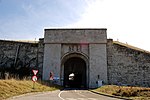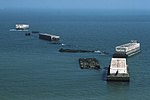Bibby Stockholm
1976 shipsBargesDormitory shipsIMO numbersImmigration to the United Kingdom

Bibby Stockholm, an engineless barge, is an accommodation vessel owned by the shipping and marine operations company Bibby Line.
Excerpt from the Wikipedia article Bibby Stockholm (License: CC BY-SA 3.0, Authors, Images).Bibby Stockholm
Rotherham Road,
Geographical coordinates (GPS) Address Nearby Places Show on map
Geographical coordinates (GPS)
| Latitude | Longitude |
|---|---|
| N 50.5688 ° | E -2.4353 ° |
Address
Rotherham Road
DT5 1PB , Portland
England, United Kingdom
Open on Google Maps









